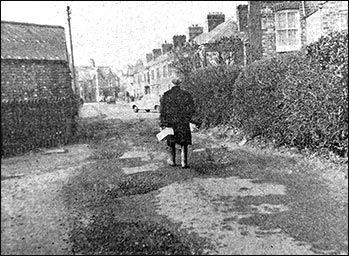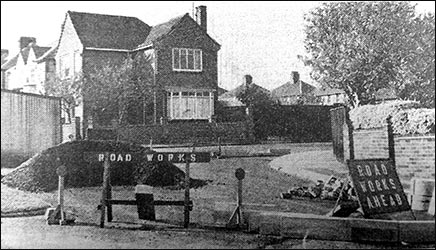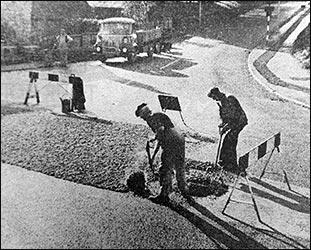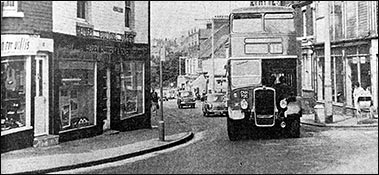The Rushden Echo and Argus, 5th February 1960
OFFICIAL NOTICES
Urban District Council of Rushden
Highways Act 1959
Alpine Road
Notice is Hereby Given, that the Urban District Council of Rushden at a meeting held on the 27th day of January, 1960, resolved to execute street works in Alpine Road, from Cresswell Road to Birchall Road.
AND NOTICE IS FURTHER GIVEN that for a period of one month from the fifth day of February 1960, a copy of the Council's resolution and of the specification, plan, sections, estimate and provisional apportionment of expenses, relating to the works, will be kept deposited at the offices of the said Council, Council Buildings, Rushden, and will be open to inspection at all reasonable times. During the said period of one month any owner of any premises shown in the provisional apportionment as liable to be charged with any part of the expenses of executing the works may, by written notice served on the Council, object to the proposals on any of the grounds specified in section 177 of the Highways Act, 1959.
Dated this fifth day of February, 1960.
A. G. CROWDY, Clerk of the Council,
Council Buildings,
Rushden.
|
The Rushden Echo, 29th January 1965, transcribed by Jim Hollis
Badly needed road repairs
Rushden Urban Council has provisionally agreed to spend £25,000 on the reconstruction of footpaths and the reshaping, re-treading and resurfacing of four roads in the town.
The roads are Westfield Avenue, St. Margaret’s Avenue, Park Avenue and Ditchford Lane (under agreement with British Rail).
The council also heard a report from the surveyor, Mr. W. J. Anker, concerning other roads which need attention, at an estimated cost of £40,000.
Another Year
These are Glassbrook, Spencer, Pratt and Robinson roads, and Mr. Anker stated that their condition was such that they could be left for at least another year.
A survey by the “Echo” of the roads mentioned to the council proved that the last mentioned are definitely in a better state than those in which the council proposes to deal this year.
St. Margaret’s Avenue has subsided in many places and there are numerous pot holes, particularly at the top half, where heavy vehicles are regularly using the road to the new building site.
One pothole in Westfield Avenue measured about nine inches, in fact, the road seemed to be deteriorating into another “Wilson’s puddle.
All the other roads mentioned in this group are in desperate need of repair. Footpaths, too, need reconstructing.
Patched
The last mentioned group of roads, which will cost an estimated £40,000 to put right, all show signs similar to the others but to a lesser degree. In fact, they have been patched up.
Generally in the Robinson Road and Pratt Road area it was felt that the roads did need remaking. They felt the footpaths needed attention. Both these roads are narrow and have sharp corners.
Residents pointed out that each time a vehicle comes round the corner and meets another it has to almost scrape the kerb, thus causing considerable subsidence at the edges over the years.
|
The Rushden Echo, 19th February 1965, transcribed by Jim Hollis
Letter Sparks off a Bone of Contention
 |
|
The road as it joins Cromwell Road by Newton Road School
|
Anonymous letters are not worth the paper they are written on, but one which was sent to Rushden Urban Council has sparked off what has long been a local bone of contention – who is responsible for the repair of Hayden Road?
Is it the responsibility of the Urban Council or the property owners – such as the Rushden Town Football Club – who have direct access on to the road?
Last week the council received a letter, supposedly from the secretary of the football club, complaining about the state of Hayden Road.
The club secretary, Mr. Ken Ambridge, did not write the letter, but it does express the club’s feelings on the subject.
The letter alleged that supporters were staying away from matches because of the state of Hayden Road.
As the letter was sent to the council the author obviously presumes that it is its responsibility to have the road repaired.
The council however has a firm view as to who should repair and maintain Hayden Road. It says that as the road has never been taken over by the council it is not a highway repairable by the council. Those who have frontage on the road are responsible for its up-keep.
Rushden Football Club disputes this view-point.
They say that just after the war, when Hayden Road was a private road; it was the club, with help from the Allotment Association and the residents of Magpie Hall, who had the road tar-maced.
The council built houses in Short Stocks and Grafton Road, and Hayden Road was dug up by the council for storm sewers. Later it was used by contractors’ vehicles of all weights and sizes.
This, the club maintains, is what caused the initial deterioration. And because of the council houses the road has subsequently been used as a public thoroughfare.
Mr. J. Cox, who owns a fish shop in Hayden Road, describes the road as a “quagmire and a disgrace.”
“Every Tom, Dick and Harry uses it, including the council,” he says.
In addition to the state of the road Mr. Cox complains about the lack of lighting.
|
The Rushden Echo, 1st October 1966, transcribed by Jim Hollis
Mystery of Missing Workmen
Road work signs, a pile of gravel, loose paving stones, and a workman’s hut, but not a workman in sight – that is the situation in Park Avenue, Rushden.
The workmen in this case are – or rather were - relaying the footpath in Park Avenue on behalf of Rushden Urban Council, by replacing the paving slabs and grass verge with tarmac.
They started the job about four or five weeks ago and for the first couple of weeks the work progressed extremely well. Then, almost as suddenly as it started, the work stopped.
 |
|
The road works
|
The items have been left near the traffic island separating the Park Avenue, Talbot Road and “No Name Street” junctions. The latter is so called by local residents because so far nobody has got round to giving the road an official title.
By taking over a large triangle of the road – it is cut off by a line of red warning lamps on each side of the island – it means one side of the island is completely blocked to traffic.
Mr. Ross Neville, a Rushden business man, who lives opposite the island, told the “Echo” that nobody had worked on the footpaths for the last couple of weeks.
He said he thought there was quite a danger risk, particularly as the lamp in the centre of the road island had also gone out, so he reported the matter to the council.
“Nothing happened for three days,” he said. “Then one of the workmen arrived and filled the lamps up. Now they are kept burning day and night.”
This scheme to relay the footpath in tarmac has already caused a little ill feeling, although most people will agree that taking an overall view the right decision was made.
It used to be a combination of paving slabs and grass verges and one resident complained when the council removed the paving slabs outside his house.
The slabs were used to replace the grass verge outside his house and they cost him almost £57. The council decided not to compensate him, but to give him his slabs back. One councillor described the decision as “a little high handed.” However, that is not the point in question here. What people want to know now is, when is work going to re-start.
The answer to that is within the next two weeks. Mr. G. D. Evelyn, the council’s surveyor, said the delay has been caused by several things. There had been a delay over an electricity main and some work had to be done on the road island. He added that the contractor probably had two or three other jobs to do as well.
|
The Rushden Echo, 14th October 1966, transcribed by Jim Hollis
Rushden’s ‘Quilt Street’
Some people are already beginning to rename Rushden’s High Street South “Quilt Street.” they claim that the piecemeal repair work which has been carried out on this road over the last few years makes it look more like an old-fashioned quilted bedspread than a major trunk road.
 |
|
Quilt Street - High Street South
|
There is no doubt that this stretch of the A6 – from Skinner’s Hill to Little Street – has received more attention from Northamptonshire County Council workmen that any other road in the Higham and Rushden area.
In fact, residents must find it difficult to remember when county council workmen were not digging or resurfacing the road. The path work is so great it almost constitutes a completely new surface and over the last few months activities seem to have increased.
If one includes the street widening and wall building opposite Harborough Road, repair work has been carried out on and off over the last three years.
In more recent months the work has restricted traffic to single lane, which, on one of the busiest, if not the busiest trunk roads in the town, has created traffic problems.
How much longer can people living in that area expect the work to continue? It is difficult to say, but it could be at least two years apparently.
A spokesman for the county surveyor’s trunk road section told the “Echo” that there is an overall scheme to improve the whole of High Street South from Skinner’s Hill to Wymington Road.
Waiting
Unfortunately the scheme – to widen the road to about 30 feet with adequate footpaths on each side – could not be put into operation until properties became available and money was in hand.
It would be pointless to carry out a major improvement scheme, which would cost a good deal of money, when it was known an overall scheme would be later introduced.
In the meantime certain sections of the road had to be maintained because of the heavy volume of traffic using the A6. The spokesman said as finance was a problem this work could only be carried out in small pieces as and when money became available.
“The Echo” understands there is little chance of introducing the overall scheme for at least two more years. So it would seem that local residents can expect this “bit by bit” progress for some time yet.
|
The Rushden Echo, 30th December 1966, transcribed by Jim Hollis
Pavement Work is a Puzzle to Residents
Residents of Park Avenue, Rushden, who were told eighteen months ago of proposals to resurface the pavements in this area of Rushden, were mystified when workmen came and dug parts of them up again.
One resident, who complained that the apparent lack of coordination between authorities on this section was a “waste of ratepayers money” said that in one short section of new pavement no fewer than five holes had been dug.
In one case say residents, a lamp was moved from the edge of the pavement, to a nearby site next to a wall – an alteration residents feel could have been made before the pavements were made up.
A spokesman for the East Midland Electricity Board said that to his knowledge no work had been carried out on the newly made sections – not even through emergency repairs.
In fact, he added, the board had “moved heaven and earth” to see that its new cable in the road was laid before reconstruction work was carried out. “We have been working in close liaison with the Rushden Urban Council surveyor, Mr. G. D. Evelyn,” he said.
Mr. Evelyn, however, could explain the sudden appearance of the holes. He said that the contractors engaged to lay the tarmac had inadvertently covered up a number of the stop cocks along the road, and these had been uncovered by the Rushden and Higham Ferrers Water Board.
Mr. Evelyn said that he had found that it was quite a common mistake with contractors’ labourers, but added that it would be the responsibility of the contractors to make good the patching.
|
The Rushden Echo, 5th May 1967, transcribed by Jim Hollis
Rushden High Street ‘giant’ adds to chaos
Rushden High Street – a traffic congested hazard at the best of times – has been made even more chaotic this week by a huge heating and planing machine which almost blocks one side of the road as it moves slowly up and down the High Street.
The machine heats the surface of the road and carves off the top layer, ready for a new surface to be put down. The job likely to last into next week is being undertaken by Northamptonshire County Council.
Shoppers and traders are critical of the apparent lack of planning and coordination.
As a one-way street which carries a high flow of through and in-town traffic, any obstruction large or small, is bound to cause inconvenience and congestion.
This particularly applies to this machine when it is working along the centre section of the road and large vehicles, such as a double-decker bus, try to pass.
Warning
Many people feel that with advance warning the situation could have been eased. Few knew the work was going to be done until they actually saw the machine in the High Street.
The police have been trying to ease the position with men on duty at various entry points of the High Street. They have re-directed traffic where possible, but it has not always been possible, and certainly never easy.
If there had been advance warning people would have known what to have expected and avoided the High Street where possible.
There are no re-direction signs up to guide through traffic along Wellingborough Road and Washbrook Road because, the “Echo” understands, the AA has no signs available.
Perhaps if they had had earlier notice they would have had the signs available.
|
The Rushden Echo, 14th July 1967, transcribed by Jim Hollis
‘Sandstorm’ Protest by Angry Traders - Road work sparks off Rushden row
Traders in Rushden’s Church Street whose shopfronts were covered in a thick layer of dust following tarring and gritting of the surface, have sent a strong letter of complaint to the Northamptonshire County Council expressing their “disgust and apprehension” at the way in which the work was carried out.
The protest letter signed by about twenty traders condemned the county council for the work as a result of which, their letter states “the exterior to chimney level, and the interior of properties are subject to the incursion of a layer of dust.”
The letter adds that the dust is “ruinous to paint and furnishings, stock and food stuffs” and that they hold the county council responsible for any loss or damage resulting from the depositing of this filth.”
The trouble for the shopkeepers and also for any unsuspecting shoppers in the area, began on Thursday.
Heavy Traffic
In the morning the road was tarred and the grit laid but as temperatures and the wind rose during the day the heavy traffic on the road – part of the A6 truck road – created a virtual “sandstorm”, which is how one woman described it.
 |
|
Church Street
|
By late afternoon the middle of the road looked as though it had not been touched, the reason being most of it had settled as dust on everything in sight.
A fruit and vegetable shop had to take its produce inside and shut the door despite the high temperature, which then began to affect the fresh fruit. Mr. E. R. Cutmore, who owns a motor cycle shop and who organised the petition of complaint, said all the machines in his building were covered in a layer of dust and from the look of the building he said it was like “working under a cement works.”
Other traders found they could hardly see out of their normally highly polished windows and shoppers had waves of dust thrown in their faces and settling on their clothes as the heavy commercial vehicles made their way through the narrow street.
The county council workmen arrived on Friday morning to shovel the grit to the sides of the road and called on the help of the Rushden council, who arrived on the scene with a mechanical sweeper and sprinkled water on the surface, but to no avail.
Slag dust was put down by the county council on Friday and the sweepers were out again on Saturday.
On Monday slag dust was put down for a second time but as the temperature rose the tar melted and the road looked more like a black river.
Mr. P. H. Cadman, deputy county surveyor, told the “Echo” that the work had been a purely temporary measure to seal patches in the road and make them waterproof.
Mr. Cadman added that one thing the council could not control was the climatic conditions which, he said, had made things as hard as possible.
Problems
“Unfortunately it was extremely hot and dry and there was the added problem of the wind blowing the dust about,” he said.
Mr. Cadman added that the county council would now be using one section of foundation in the form of a thin asphalt carpet and this would be applied down the whole length of road in the autumn and should make an extremely good surface for several years to come.
|
|